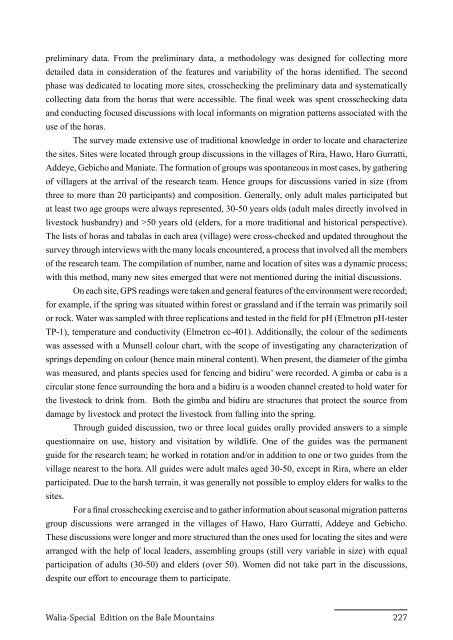Walia Special Edition on the Bale Mountains (2011) - Zoologische ...
Walia Special Edition on the Bale Mountains (2011) - Zoologische ...
Walia Special Edition on the Bale Mountains (2011) - Zoologische ...
Create successful ePaper yourself
Turn your PDF publications into a flip-book with our unique Google optimized e-Paper software.
preliminary data. From <strong>the</strong> preliminary data, a methodology was designed for collecting more<br />
detailed data in c<strong>on</strong>siderati<strong>on</strong> of <strong>the</strong> features and variability of <strong>the</strong> horas identified. The sec<strong>on</strong>d<br />
phase was dedicated to locating more sites, crosschecking <strong>the</strong> preliminary data and systematically<br />
collecting data from <strong>the</strong> horas that were accessible. The final week was spent crosschecking data<br />
and c<strong>on</strong>ducting focused discussi<strong>on</strong>s with local informants <strong>on</strong> migrati<strong>on</strong> patterns associated with <strong>the</strong><br />
use of <strong>the</strong> horas.<br />
The survey made extensive use of traditi<strong>on</strong>al knowledge in order to locate and characterize<br />
<strong>the</strong> sites. Sites were located through group discussi<strong>on</strong>s in <strong>the</strong> villages of Rira, Hawo, Haro Gurratti,<br />
Addeye, Gebicho and Maniate. The formati<strong>on</strong> of groups was sp<strong>on</strong>taneous in most cases, by ga<strong>the</strong>ring<br />
of villagers at <strong>the</strong> arrival of <strong>the</strong> research team. Hence groups for discussi<strong>on</strong>s varied in size (from<br />
three to more than 20 participants) and compositi<strong>on</strong>. Generally, <strong>on</strong>ly adult males participated but<br />
at least two age groups were always represented, 30-50 years olds (adult males directly involved in<br />
livestock husbandry) and >50 years old (elders, for a more traditi<strong>on</strong>al and historical perspective).<br />
The lists of horas and tabalas in each area (village) were cross-checked and updated throughout <strong>the</strong><br />
survey through interviews with <strong>the</strong> many locals encountered, a process that involved all <strong>the</strong> members<br />
of <strong>the</strong> research team. The compilati<strong>on</strong> of number, name and locati<strong>on</strong> of sites was a dynamic process;<br />
with this method, many new sites emerged that were not menti<strong>on</strong>ed during <strong>the</strong> initial discussi<strong>on</strong>s.<br />
On each site, GPS readings were taken and general features of <strong>the</strong> envir<strong>on</strong>ment were recorded;<br />
for example, if <strong>the</strong> spring was situated within forest or grassland and if <strong>the</strong> terrain was primarily soil<br />
or rock. Water was sampled with three replicati<strong>on</strong>s and tested in <strong>the</strong> field for pH (Elmetr<strong>on</strong> pH-tester<br />
TP-1), temperature and c<strong>on</strong>ductivity (Elmetr<strong>on</strong> cc-401). Additi<strong>on</strong>ally, <strong>the</strong> colour of <strong>the</strong> sediments<br />
was assessed with a Munsell colour chart, with <strong>the</strong> scope of investigating any characterizati<strong>on</strong> of<br />
springs depending <strong>on</strong> colour (hence main mineral c<strong>on</strong>tent). When present, <strong>the</strong> diameter of <strong>the</strong> gimba<br />
was measured, and plants species used for fencing and bidiru’ were recorded. A gimba or caba is a<br />
circular st<strong>on</strong>e fence surrounding <strong>the</strong> hora and a bidiru is a wooden channel created to hold water for<br />
<strong>the</strong> livestock to drink from. Both <strong>the</strong> gimba and bidiru are structures that protect <strong>the</strong> source from<br />
damage by livestock and protect <strong>the</strong> livestock from falling into <strong>the</strong> spring.<br />
Through guided discussi<strong>on</strong>, two or three local guides orally provided answers to a simple<br />
questi<strong>on</strong>naire <strong>on</strong> use, history and visitati<strong>on</strong> by wildlife. One of <strong>the</strong> guides was <strong>the</strong> permanent<br />
guide for <strong>the</strong> research team; he worked in rotati<strong>on</strong> and/or in additi<strong>on</strong> to <strong>on</strong>e or two guides from <strong>the</strong><br />
village nearest to <strong>the</strong> hora. All guides were adult males aged 30-50, except in Rira, where an elder<br />
participated. Due to <strong>the</strong> harsh terrain, it was generally not possible to employ elders for walks to <strong>the</strong><br />
sites.<br />
For a final crosschecking exercise and to ga<strong>the</strong>r informati<strong>on</strong> about seas<strong>on</strong>al migrati<strong>on</strong> patterns<br />
group discussi<strong>on</strong>s were arranged in <strong>the</strong> villages of Hawo, Haro Gurratti, Addeye and Gebicho.<br />
These discussi<strong>on</strong>s were l<strong>on</strong>ger and more structured than <strong>the</strong> <strong>on</strong>es used for locating <strong>the</strong> sites and were<br />
arranged with <strong>the</strong> help of local leaders, assembling groups (still very variable in size) with equal<br />
participati<strong>on</strong> of adults (30-50) and elders (over 50). Women did not take part in <strong>the</strong> discussi<strong>on</strong>s,<br />
despite our effort to encourage <strong>the</strong>m to participate.<br />
<str<strong>on</strong>g>Walia</str<strong>on</strong>g>-<str<strong>on</strong>g>Special</str<strong>on</strong>g> <str<strong>on</strong>g>Editi<strong>on</strong></str<strong>on</strong>g> <strong>on</strong> <strong>the</strong> <strong>Bale</strong> <strong>Mountains</strong> 227
















